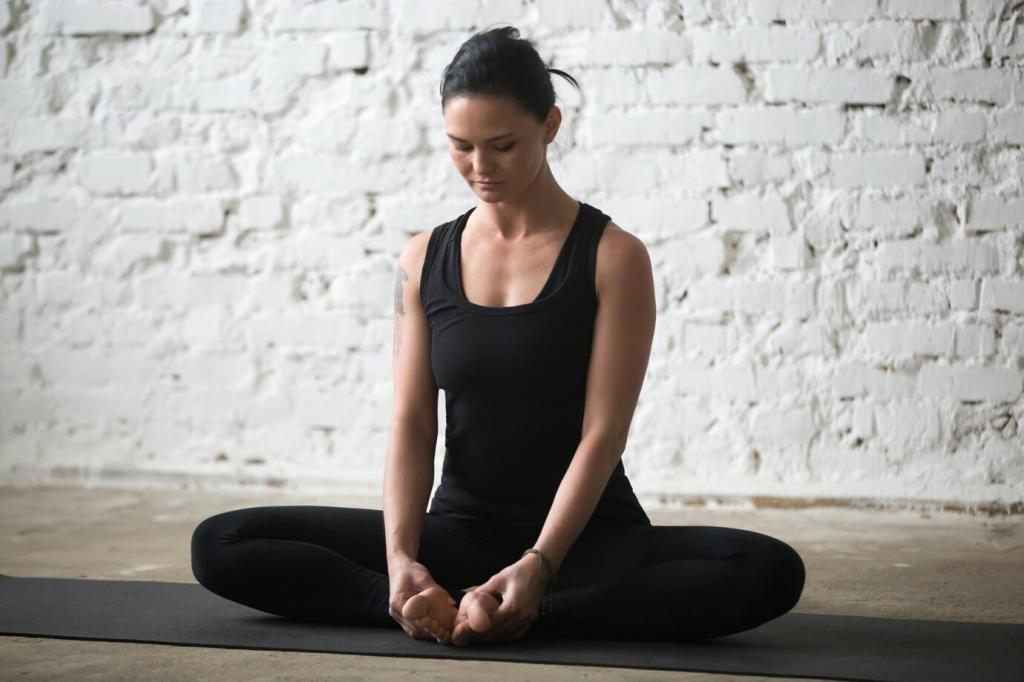Core Yoga Poses for New Practitioners
Chosen theme: Core Yoga Poses for New Practitioners. Welcome to a steady, welcoming start to your yoga journey—rooted in clear alignment, gentle progress, and encouraging guidance you can return to anytime. Subscribe and say hello so we can cheer on your first steps together.

Begin with Breath and Mountain: Your Grounded Foundation
Breath Before Everything
Inhale to lift through the spine, exhale to soften the jaw and shoulders. This simple rhythm steadies nerves, fuels endurance, and helps new practitioners feel present, safe, and calm as they explore core yoga poses for the very first time.
Building Mountain Pose Step by Step
Stand with feet hip-width, press evenly through heels and toes, lengthen the crown, and broaden the collarbones. A gentle abdominal tone supports the lower back while the breath invites clarity. Share a quick selfie stance and tell us how Mountain feels today.
Common Beginner Tweaks
Locked knees? Soften. Swaying lower back? Engage the lower belly slightly. Tight shoulders? Float them down. These tiny adjustments help new practitioners stack joints, discover balance, and create an easy, confident posture that supports every pose that follows.
Downward Dog and Plank: Strength That Meets Ease
Aligning Downward Facing Dog
Spread your fingers, press through palms, and lift hips toward the sky while keeping knees softly bent if hamstrings feel tight. Aim for a long spine instead of straight legs. Tell us where you feel the stretch most, and we’ll offer personalized tips.
Plank Without Strain
Shift shoulders above wrists, push the floor away, and knit ribs gently toward the spine. Engage thighs and glutes to support the back. The goal is stability, not punishment. Try ten slow breaths, then comment with your favorite playlist for focus.
A Beginner’s Story: Finding the Shake
Maya’s first week brought Tremble City in Plank and a wobbly Down Dog. On day three, she softened her knees, broadened her shoulders, and suddenly her breath synced. Strength followed naturally. Share your day three moment—big or small—so others can celebrate with you.
Warriors I and II: Stand Tall in Your Space
Setting the Feet and Hips
In Warrior I, angle your back heel down and guide hips gently forward. In Warrior II, open the hips and track the front knee over the middle toes. These foundations protect your joints and give beginning students a powerful, safe stance to grow from.
Finding Your Gaze and Breath
Choose a drishti point—something still—and breathe evenly. With every exhale, root deeper through your feet. With every inhale, expand your chest and reach. Notice how intention rises when alignment feels supported. Comment with your favorite Warrior affirmation today.
Mini-Sequence for Beginners
Flow from Warrior I to Warrior II, then to a gentle Reverse Warrior, three slow breaths each. Move like honey—smooth and patient. This simple trio builds strength, opens the side body, and teaches transitions that feel approachable and repeatable for new practitioners.
Choose Your Root with Care
Place your foot at the ankle or calf, never on the knee. Press foot and leg gently together while lengthening through the crown. Wobbles are welcome; they mean your body is learning. Tell us your favorite grounding image: roots, ocean waves, or mountain air.
Use a Wall, Keep Your Pride
Start with one fingertip to the wall. As confidence grows, hover fingers, then float hands to heart. Progress is progress, even in tiny steps. Invite a friend to try Tree with you, and share who held steady the longest—laughter absolutely counts as core engagement.
Gentle Backbends: Cobra and Bridge for Open Hearts
In Cobra, hug elbows in and pull the chest forward rather than jamming upward. In Bridge, press through heels and engage hamstrings. Light belly tone and long necks keep everything safe. Share your after-backbend mood in one word so newcomers feel encouraged.
Slide a folded blanket under hips in Cobra or place a block under the sacrum in Supported Bridge. These variations let beginners explore sensation, breath, and space with zero urgency. Comment if you try a prop and notice a calmer, steadier backbend experience.
Inhale to prepare, exhale to lift gently, then pause and breathe. Let the heart brighten while shoulders soften away from ears. Quality beats height every time. Tag us in your practice recap and note one cue that helped you feel safe and strong today.
Restore and Reflect: Child’s Pose and Seated Fold
Child’s Pose, Always Here for You
Knees wide or together, forehead resting, arms forward or alongside the body—choose comfort. This is your reset button whenever breathing feels rushed. Invite calm with three slow exhalations, then comment about one moment today when this restful shape supported you.
Hamstring-Friendly Seated Fold
Bend knees as needed, hinge from hips, and lengthen the spine before folding. You are not chasing your toes; you are greeting your breath. A strap around the feet can help beginners maintain alignment while enjoying a gentle, sustainable stretch without discomfort.
Reflect, Track, Celebrate
After practice, jot two sensations and one question. Progress becomes visible when you write it down. Share a line from your reflection with our community, and subscribe for weekly beginner sequences that build on today’s core yoga poses with care and consistency.
Join our mailing list
